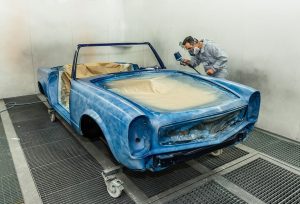
A washing station equipped with brushes to remove fooling on boats
Using the same principle as car washes, a Swedish company has developed a machine that cleans the hull of boats using moving brushes. It allows to remove the fooling on the hull and is ecological, because it avoids the application of antifooling paints, harmful for the environment.
All boats are confronted with fooling, this natural phenomenon of spontaneous colonization of the submerged part of the hull by different types of organisms (bacteria, unicellular algae, green algae, etc.). It makes boats difficult to maneuver and increases the fuel consumption of motorized ones. To delay this process, the most commonly used technique is to apply antifooling paint to the hull. This contains biocides and is therefore harmful to the environment. Its use is furthermore limited by decrees. Faced with this problem, the Swedish company Rentunder AB has developed an alternative solution inspired by car wash stations.

The process is purely mechanical and is based on brushes, the rotation of which removes the fooling. Installed in ports, it is in the form of a U with floating pontoons arranged on three sides. The boat enters through the open one, then a door closes behind it, according to the same principle as the sectional doors of car garages. Horizontal brushes are then positioned on each side of the hull to clean it and automatically adapt to its shape. This process is suitable for boats not exceeding 6 meters in length and a draft (vertical distance between the waterline and the bottom of the keel) of 2.4 m. An additional brush is also used to clean the waterline, and under the hull, brushes mounted on jacks have the function of cleaning the keel.
A retention basin is positioned under the brushes to collect the waste which is then pumped, then filtered, before being evacuated to a specialized sorting centre. “Initially, chips of antifooling paint come off with the organisms, but the long-term objective is to stop using paint and clean the hull regularly with this machine,” explains Gaël Minier, President of G&G Boatwash, the company that imports this equipment into France and several neighboring countries.
The washing station can adapt to the depth of the ports
This equipment won the innovation competition at the last Paris boat show in the Service category. For the moment, only one machine is installed in France, in Les Sables-d’Olonne. It was first assembled and tested in Sweden, then disassembled to be transported in the form of a module to its destination. The set weighs just under 5 tons, and transport is provided using two semi-trailers or two containers. “This brushing system is robust and weighs 800 kg, adds Gaël Minier. The standard machine has a draft of 3.2 m, but it is possible to adapt it according to the different depths of the ports. Hydraulic motors and hoses contain biodegradable oil so as not to pollute the water in the event of a leak. »
This process requires regular cleaning of the hull, the frequency of which depends on the type of water. For boats navigating on lakes or in cold waters such as those located in Sweden, it is necessary to wash the hull twice a year. In the waters of the Atlantic zone, the cleaning should be done between 6 to 7 times a year, and in warm waters like those of Miami, it should be done monthly. On the other hand, the process is not suitable for boats that have remained for example two years in the water and on the hull of which are glued 100 kg of mussels.

Despite the need for this regular cleaning, this process nevertheless proves to be economical, according to Gaël Minier: “It does not cost more than the cost of the application of an antifooling paint carried out by the owner of his boat, because you have to count the cranage, the sanding and the painting. And it costs less than the professional solution of applying antifooling paint at a shipyard. In Les Sables-d’Olonne, unit washing costs between 40 and 210 euros depending on the size of the boats, and it is possible to subscribe to an unlimited number of cleanings per year for a price starting at 300 euros, for boats measuring 6 meters, to 1,750 euros, for those reaching 16 meters.
This cleaning takes a short time, about a quarter of an hour. It has the advantage of keeping the hull of boats permanently clean and thus saves fuel consumption. Currently, the machine is controlled by an operator using a wi-fi remote control, but the Swedish manufacturer is continuing its research and development work to make the station completely autonomous, like car wash stations.

